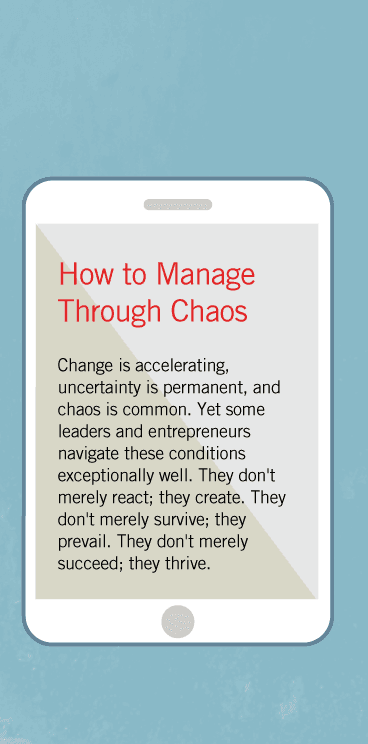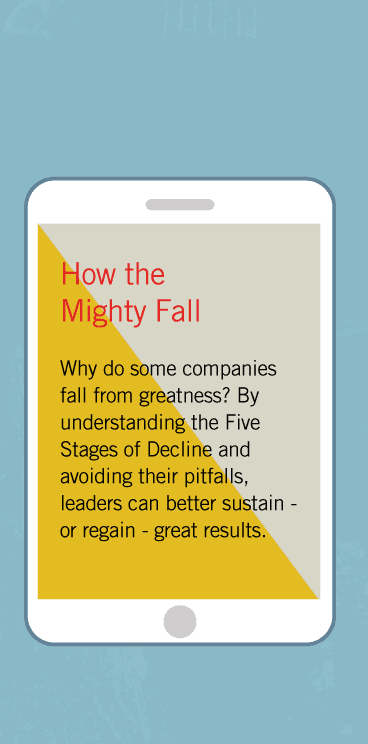HalfTime
By Bob Buford
November 2007
Bob Buford has a peculiar genius for inspiring people to embrace discomfort. I first met Bob in 1996 when he asked me to teach pastors from large evangelical churches. I knew nothing about megachurches, and I wondered if I could possibly contribute to their thinking. “All the more reason to do it!” responded Buford. “It will force you to learn something new that you can contribute to others. You have no idea what you will learn when you engage these church leaders—and that will make you more useful.”
Bob turned out to be right about the learning adventure. Part way through the megachurch session, while I was encouraging pastors to create churches built to last, a hand shot up in the back.
“Jim, now why is this important?” queried a pastor from South Carolina.
“Because if you don‘t think ahead about succession—if your church depends just on you and your charismatic personality—it will likely decline or fall after you leave.” I then shared the story of a once-great company whose aging founder defined succession planning as merely prefacing a statement every month or so with “If I happen to be unavailable . . . .”
The pastor looked at me almost with pity, as if I‘d somehow missed first grade, then said in a slow, deliberate drawl, “Now, Mr. Collins, I think you‘re, ah, missing a fundamental point here,” pausing for effect. “See, our founder,” - another pause - “well, he‘s never unavailable.”
The room erupted into laughter, and I noticed Buford nodding at me, as if to say, “See, I told you that you‘d be pushed by this and you‘ll be better for it.” I went home and rethought the built-to-last ideas in the context of religious leadership, and thus began a lasting friendship that has been a continual source of renewal for me.
Buford kept pushing and challenging. During one of our long conversations, I asked Buford (who happens to be the best emissary for Christianity I‘ve yet to meet), “How did Christianity transform itself from a handful of fanatics wandering around a remote backwater of the Roman Empire into the official religion of the most powerful empire in the world three hundred years later? To use an analogy, it would be like two dozen people starting a new religion thirty miles from Bagdad today and turning it into the official religion of the United States a century or two down the road—and doing it without any mass communication. How did this happen?” Buford responded by asking knowledgeable Christian historians, collecting their answers, and sending me a banker‘s box of data and information to read and digest—another challenge, another opportunity for learning and renewal, another Bob Buford jolt.
There is a delicious irony in Bob‘s asking me to pen this foreword: I‘m right smack in the middle of half-time, as I‘m turning fifty. Buford slyly got me to engage with his work at the very moment when it will do me the most good. I do not have the answers, but Buford has given me—and all those who read his book—the right question: Why capitulate to irrelevance after we‘ve spent decades accumulating empirical wisdom?
In the first half of the twentieth century, people largely viewed work as a necessary evil, a way to provide security and comfort. Then, in the 1960s, people began to demand more from their careers—they wanted meaning and a sense of purpose. And now Bob Buford comes along with the next challenge: to think beyond the narrow bounds of a satisfying and successful career to a meaningful and useful entire life. Here in Halftime, he asserts that the old model of arduous career followed by relaxing retirement should be jettisoned, replaced by the idea that the second half can—and should—be more creative, more impactful, more meaningful, more adventurous, filled with more learning and contribution than the first half. A successful first fifty years should be viewed as nothing more than a good start.
Most who read Buford‘s work have already attained success, and find it wanting. And when we reach half- time, when we know we have fewer days ahead than behind—when our mentors and teachers and moms and dads begin to die—the idea of just “more success” does not answer the question “What‘s the point?” Have you answered the question, “What‘s the one thing—not two things, not three, not four, but the one big thing—in the box?” Have you written your own epitaph? Have you articulated a strategy for multiplying your contribution by 100X? Have you answered “How much is enough?” Have you done “seismic testing” to discover where you can best be of service? Have you organized your time around two essential elements of a complete life: self-realization and community? If you‘re ready for these questions, you‘re ready for Halftime.
In puzzling on Buford‘s questions, I‘ve come to see two distinct approaches to self-renewal—and I encourage you consider both as you read this book. The first lies in the late John Gardner‘s idea of repotting ourselves into entirely new activities as we move from success to significance, changing our activities from career to contribution. Gardner, former Secretary of health, education, and welfare (and author of the classic Self-Renewal), once told me that he planned to learn and grow as much between seventy and eighty-eight as between zero and eighteen. When challenged, Gardner said that he knew a little bit more about learning at seventy than when he was zero. Gardner pushed people to think about “repotting” themselves every ten to fifteen years, throwing themselves into challenges that extract hidden strengths. Buford picks up where Gardner left off, challenging us to see that some of our most significant and meaningful contributions should come in the second half, defying the view that creativity wanes with age. By repotting, you can recreate the sense of excitement and imagination experienced in your teens or twenties—again and again and again. Repotting also has the wonderful side benefit of slowing down time. Think about how vivid your experience was the first few weeks of moving to a new school, new city, new company, or new country - the very newness heightened your senses and deepened your memories - compared with how you experienced the fiftieth or one hundredth week, when life has become routine.
The second path to self-renewal lies in seeing your primary activity—the same activity you‘ve pursued for your first half—as the primary means to renewal. For some, the best choice lies on the second path, choosing to renew within a chosen genre or field, much as an artist grows within his or her craft. Beethoven didn‘t reach half time and then give up music to renew; he stayed focused and created some of his most radical, path-breaking music. Would Beethoven been of more use giving up music to find significance? Like Beethoven, Peter Drucker took the second path, and it is entirely fitting that Drucker wrote the first foreword to this book.
Drucker‘s books fill three bookshelves at Claremont Graduate University; as a Claremont friend of mine pointed out, “Notice that his writings before age sixty-five sit on one shelf and his writings after sixty-five require two shelves.” When I asked Peter Drucker, then aged eighty-six, which of his twenty-six books he was proudest of, he responded, “The next one.” For some, being a CEO (or a writer or a church leader or a professor) is their art, and if this describes you, the question becomes, if you‘ve only written four symphonies by half time, what will be symphonies 5, 6, 7, 8 and 9—and how can you make your ninth symphony the most extraordinary of all?
So, be forewarned before you become acquainted with Bob Buford through the pages that follow. Do not read this book if you want your life to be easy and comfortable. Do not read this book if you want to coast to the finish line. Do not read this book if you want to mainly take rather than to give. But if you have a deep desire to be of use, to learn and to grow right up until the day you die, you‘ll find Halftime an invigorating challenge. The question of renewal stays with us for our entire lives. Some answer the question with tremendous grace and creativity, becoming “seventy years young”; others, sadly, begin to age early, reaching half-seventy as “thirty-five years old.” And while Buford has employed the half time analogy with tremendous effect, there remains one huge difference between a sport and life: in football (or in a marathon or on a mountain climb) you know exactly when you‘ve crossed the halfway mark. In life, you might think you‘ve reached halftime, but in fact be at mile twenty-five of the twenty-six-mile marathon, or in the last two minutes of the fourth quarter, or perhaps—if fortunate—still only a third of the way up the mountain. We only get one life, and the urgency of getting on with what we‘re meant to do increases every day. The clock is ticking.
Bob turned out to be right about the learning adventure. Part way through the megachurch session, while I was encouraging pastors to create churches built to last, a hand shot up in the back.
“Jim, now why is this important?” queried a pastor from South Carolina.
“Because if you don‘t think ahead about succession—if your church depends just on you and your charismatic personality—it will likely decline or fall after you leave.” I then shared the story of a once-great company whose aging founder defined succession planning as merely prefacing a statement every month or so with “If I happen to be unavailable . . . .”
The pastor looked at me almost with pity, as if I‘d somehow missed first grade, then said in a slow, deliberate drawl, “Now, Mr. Collins, I think you‘re, ah, missing a fundamental point here,” pausing for effect. “See, our founder,” - another pause - “well, he‘s never unavailable.”
The room erupted into laughter, and I noticed Buford nodding at me, as if to say, “See, I told you that you‘d be pushed by this and you‘ll be better for it.” I went home and rethought the built-to-last ideas in the context of religious leadership, and thus began a lasting friendship that has been a continual source of renewal for me.
Buford kept pushing and challenging. During one of our long conversations, I asked Buford (who happens to be the best emissary for Christianity I‘ve yet to meet), “How did Christianity transform itself from a handful of fanatics wandering around a remote backwater of the Roman Empire into the official religion of the most powerful empire in the world three hundred years later? To use an analogy, it would be like two dozen people starting a new religion thirty miles from Bagdad today and turning it into the official religion of the United States a century or two down the road—and doing it without any mass communication. How did this happen?” Buford responded by asking knowledgeable Christian historians, collecting their answers, and sending me a banker‘s box of data and information to read and digest—another challenge, another opportunity for learning and renewal, another Bob Buford jolt.
There is a delicious irony in Bob‘s asking me to pen this foreword: I‘m right smack in the middle of half-time, as I‘m turning fifty. Buford slyly got me to engage with his work at the very moment when it will do me the most good. I do not have the answers, but Buford has given me—and all those who read his book—the right question: Why capitulate to irrelevance after we‘ve spent decades accumulating empirical wisdom?
In the first half of the twentieth century, people largely viewed work as a necessary evil, a way to provide security and comfort. Then, in the 1960s, people began to demand more from their careers—they wanted meaning and a sense of purpose. And now Bob Buford comes along with the next challenge: to think beyond the narrow bounds of a satisfying and successful career to a meaningful and useful entire life. Here in Halftime, he asserts that the old model of arduous career followed by relaxing retirement should be jettisoned, replaced by the idea that the second half can—and should—be more creative, more impactful, more meaningful, more adventurous, filled with more learning and contribution than the first half. A successful first fifty years should be viewed as nothing more than a good start.
Most who read Buford‘s work have already attained success, and find it wanting. And when we reach half- time, when we know we have fewer days ahead than behind—when our mentors and teachers and moms and dads begin to die—the idea of just “more success” does not answer the question “What‘s the point?” Have you answered the question, “What‘s the one thing—not two things, not three, not four, but the one big thing—in the box?” Have you written your own epitaph? Have you articulated a strategy for multiplying your contribution by 100X? Have you answered “How much is enough?” Have you done “seismic testing” to discover where you can best be of service? Have you organized your time around two essential elements of a complete life: self-realization and community? If you‘re ready for these questions, you‘re ready for Halftime.
In puzzling on Buford‘s questions, I‘ve come to see two distinct approaches to self-renewal—and I encourage you consider both as you read this book. The first lies in the late John Gardner‘s idea of repotting ourselves into entirely new activities as we move from success to significance, changing our activities from career to contribution. Gardner, former Secretary of health, education, and welfare (and author of the classic Self-Renewal), once told me that he planned to learn and grow as much between seventy and eighty-eight as between zero and eighteen. When challenged, Gardner said that he knew a little bit more about learning at seventy than when he was zero. Gardner pushed people to think about “repotting” themselves every ten to fifteen years, throwing themselves into challenges that extract hidden strengths. Buford picks up where Gardner left off, challenging us to see that some of our most significant and meaningful contributions should come in the second half, defying the view that creativity wanes with age. By repotting, you can recreate the sense of excitement and imagination experienced in your teens or twenties—again and again and again. Repotting also has the wonderful side benefit of slowing down time. Think about how vivid your experience was the first few weeks of moving to a new school, new city, new company, or new country - the very newness heightened your senses and deepened your memories - compared with how you experienced the fiftieth or one hundredth week, when life has become routine.
The second path to self-renewal lies in seeing your primary activity—the same activity you‘ve pursued for your first half—as the primary means to renewal. For some, the best choice lies on the second path, choosing to renew within a chosen genre or field, much as an artist grows within his or her craft. Beethoven didn‘t reach half time and then give up music to renew; he stayed focused and created some of his most radical, path-breaking music. Would Beethoven been of more use giving up music to find significance? Like Beethoven, Peter Drucker took the second path, and it is entirely fitting that Drucker wrote the first foreword to this book.
Drucker‘s books fill three bookshelves at Claremont Graduate University; as a Claremont friend of mine pointed out, “Notice that his writings before age sixty-five sit on one shelf and his writings after sixty-five require two shelves.” When I asked Peter Drucker, then aged eighty-six, which of his twenty-six books he was proudest of, he responded, “The next one.” For some, being a CEO (or a writer or a church leader or a professor) is their art, and if this describes you, the question becomes, if you‘ve only written four symphonies by half time, what will be symphonies 5, 6, 7, 8 and 9—and how can you make your ninth symphony the most extraordinary of all?
So, be forewarned before you become acquainted with Bob Buford through the pages that follow. Do not read this book if you want your life to be easy and comfortable. Do not read this book if you want to coast to the finish line. Do not read this book if you want to mainly take rather than to give. But if you have a deep desire to be of use, to learn and to grow right up until the day you die, you‘ll find Halftime an invigorating challenge. The question of renewal stays with us for our entire lives. Some answer the question with tremendous grace and creativity, becoming “seventy years young”; others, sadly, begin to age early, reaching half-seventy as “thirty-five years old.” And while Buford has employed the half time analogy with tremendous effect, there remains one huge difference between a sport and life: in football (or in a marathon or on a mountain climb) you know exactly when you‘ve crossed the halfway mark. In life, you might think you‘ve reached halftime, but in fact be at mile twenty-five of the twenty-six-mile marathon, or in the last two minutes of the fourth quarter, or perhaps—if fortunate—still only a third of the way up the mountain. We only get one life, and the urgency of getting on with what we‘re meant to do increases every day. The clock is ticking.
JIM COLLINS
Boulder, Colorado
November, 2007
Copyright © 2008 Jim Collins, All rights reserved.






